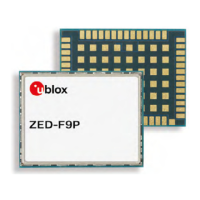ZED-F9P-Integration Manual
UBX-18010802 - R01
1 Overview Page 9 of 64
Objective Specification - Confidential
The relevant RTCM standard NTRIP V2 can be downloaded from the RTCM standards website:
http://www.rtcm.org/differential-global-navigation-satellite--dgnss--standards.html
1.8 Virtual Reference Station
In order for VRS to work the VRS Caster needs to know the location of the Rover receiver. To
do this the Rover has to output the NMEA GGA message and this has to be sent to the VRS
Caster. Typically only the NMEA GGA message is needed.
Reaching centimeter-level accuracy of positioning typically requires use of precise dual-frequency
carrier phase observations. Furthermore, these observations are usually processed using a
differential GNSS (DGNSS) algorithm, such as real time kinematic (RTK) or post-processing (PP).
Regardless of the specific differential algorithm, however, implicit in the process is an assumption
that the quality of the reference station data is consistent with the desired level of positioning
accuracy. The virtual reference station (VRS) concept can help to satisfy this requirement using
a network of reference stations. As a quick review, a typical DGNSS setup consists of a single
reference station from which the raw data (or corrections) are sent to the rover receiver (i.e., the
user). The user then forms the carrier phase differences (or corrects their raw data) and performs
the data processing using the differential corrections. In contrast, GNSS network architectures
often make use of multiple reference stations. This approach allows a more precise modeling
of distance-dependent systematic errors principally caused by ionospheric and tropospheric
refractions, and satellite orbit errors. More specifically, a GNSS network decreases the dependence
of the error budget on the distance of nearest antenna. The picture below shows the network of
reference stations used to build up a service covering the whole of Switzerland.
Figure 4: VRS network in Switzerland
The network of receivers is linked to a computation center, and each station contributes its raw data
to help create network-wide models of the distance-dependent errors. The computation of errors
based on the full network’s carrier phase measurements involves, first of all, the resolution of carrier
phase ambiguities and requires knowledge of the reference station positions. (The latter is usually
determined as part of the network setup.)

